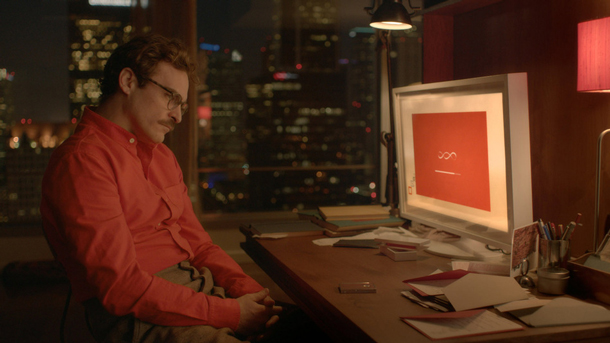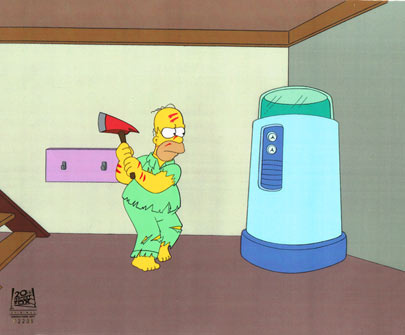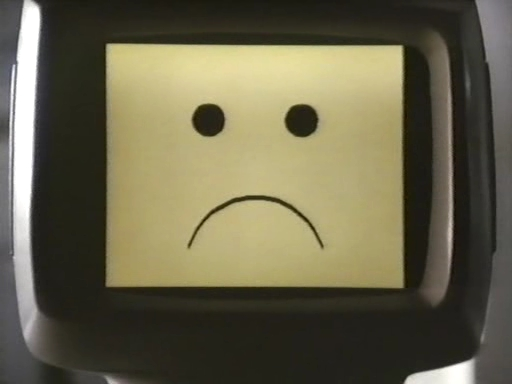
In Spike Jonze’s Oscar nominated film Her, a man starts a very personal relationship with his very personal computer. Broken-hearted sad sack Theodore Twombly falls for Samantha, his new artificially intelligent computer operating system, and she falls in love right back. Thus begins one of the most inventive love stories ever put to film. Or it would be one of the most inventive love stories, if it had never been told before. Stories of love between mankind and the man-made are almost as old as stories themselves. This is not a knock against the movie. Just because there have been innumerable tales of brave young knights saving princesses from the clutches of evil wizards doesn’t lessen the wonder of Star Wars. Likewise, Jonze’s film is brilliant because he took one of the oldest stories and made it seem as if it has never been done before. Here are some more examples of what Air Supply called “making love out of nothing at all.”
The Greek myth of Pygmalion
Medium: Ivory (alternately, a flower girl)
Pygmalion is an artist who falls in love with a sculpture of his own creation. He prays really hard to Aphrodite, the goddess of love, and what do you know? The stone turns to flesh. This early example is one of the few where things work out amicably between the human and the creation. George Bernard Shaw used this myth as a metaphor for his play of the same title in which professor Henry Higgins turns low-born Eliza Doolittle into a socialite. In turn, his play was musicalized into My Fair Lady. Eliza’s combination of earthiness and newfound self-respect makes her the only woman who can deal with the irascible Higgins. They end up together, but the relationship is much more confrontational than the one in the myth.

Ruby Sparks
Medium: The written word
In the Pygmalion myth, the two live happily ever after, but what if the sculptor realized his lover needed a little touch-up work and brought the chisel into the bedroom. In Zoe Kazan’s 2012 cautionary tale, Paul Dano is Calvin, a young writer who wakes up one day to find one of his characters, an idealized woman named Ruby, making him breakfast. They start up a manic romance, and whenever things start to go sour, he just fixes her with a few rewrites. Things get dark quick as our young lover asserts more and more creative control over his project/girlfriend. The lesson here is that manic pixie dream girls are best left in fiction. Having seen Ruby Sparks, I was expecting that Theodore would start reprogramming Samantha when she started to not act as desired. Turns out Theodore is either not so cruel, or he is lacking the programming ability.
“The Kugelmass Episode” by Woody Allen
Medium: French literature and cabinetry
It would be an odd fit for Woody Allen to write about computers. His luddite tendencies shade all of his work. In this short story he opts for literature and magic as the key to fulfilling romantic desires. Professor Kugelmass, unsatisfied with his marriage, is looking for some excitement. With the help of a magician and a supernatural cabinet he embarks on an affair with his ideal woman: literature’s favorite unfaithful spouse, Emma Bovary, causing him to rhapsodize, “My God, I’m doing it with Madame Bovary. Me, who failed Freshman English.” First he enters the novel, but soon he leads her out of 19th century France and into 1971 New York City. Things fall apart fast enough: his wife gets suspicious and Madame B gets bored and starts to make demands. Kugelmass swears off the magic cabinet. That is, until he reads Portnoy’s Complaint.
Lars and the Real Girl
Medium: Fake Girl
Just because you look like Ryan Gosling doesn’t mean your life is going to be easy. Take Lars for example. He is the most distant and socially awkward guy in town, that is, until a very special woman pulls him out of his shell. The woman though, is a life-sized sex doll. According to Lars, she’s half Danish/half Brazilian, and the reason she can’t walk is that she’s in a wheelchair. At first, this is seen as proof that he’s gone off the deep end, but like Theodore and Samantha, people support Lars’s fantasy because they like to see him happy.
“I Sing the Body Electric” by Ray Bradbury (a.k.a. “the Electric Grandmother”), originally appearing on The Twilight Zone.
Medium: Robotics
In science fiction master Ray Bradbury’s sole contribution to the Twilight Zone, a widower purchases a lifelike robotic grandmother to help care for his children. She is perfect–made just to their specifications– but one of the girls won’t accept her. Not because she is a machine, but because the death of her mother has given her a fear of abandonment. The girl’s anxieties are put to rest when her new grandmother saves her life by walking in front of a truck, then coming out unscathed. The old woman is devoted, but moves on to another family when the kids are grown, showing the fickleness of reprogramming. Bradbury adapted his own teleplay into a short story, which was in turn re-made as a t.v. movie in 1982 re-titled “The Electric Grandmother” with Maureen Stapleton in the title role, and an added epilogue which is a rare case of a happy ending that could make a stone cry.

The Simpson’s Treehouse of Horror XII: “House of Whacks”
Medium: House/computer
In fiction, computers and robots tend to struggle to understand love. This is not the case with the Simpson’s new computer, named Ultrahouse 3000. TV’s favorite family purchases an Operating System for the house. Like Samantha in Her, U3K is programmed to their specifications, or at least his voice is- they opt for smooth Pierce Brosnan’s over snarkier Matthew Perry and snarkiest Dennis Miller. The machine falls in love with Marge, who is flattered but remains devoted to Homer. Ultrahouse logically thinks that all he must do is kill his rival and Marge will be his. This Halloween short is less a commentary on digital romance, and more a spoof of the killer computer from 2001: A Space Odyssey. His motives are understandable, though. Wouldn’t you get a little HAL9000-ish if the woman you loved chose a lazy buffoon like Homer over your god-like, intelligent self?
Weird Science
Medium: Computers? Photography? Hormones? I don’t know. It’s kinda foggy.
Where can you turn if you’re a horny high school nerd in the 1980’s? Your computer, that’s where. We’re not talking about porn sites (they were rather scarce at the time). We’re talking about building a hottie through programming. Gary and Wyatt load their hard drive with photos of models (literally feeding the magazine clippings into the hard drive somehow), but wanting to ensure the woman won’t be an idiot, they put in a picture of Einstein, because that’s how science works. Out pops a supergenius, supernatural super model. She never goes all the way with our heroes, but she teaches them a lot of life lessons like how to go all the way with real women.
Electric Dreams
Medium: Computer and Alcohol
Again with the nerds! And again with Hollywood having no idea how computers work! When Miles accidentally pours champagne on his new p.c. it gives his computer artificial intelligence and a voice that sounds like Bud Cort. What happens when these two roommates fall in love with the same woman? War. The computer does a little bit of identity theft to ruin Miles’ reputation and finances, and Miles attempts a little cyber-murder by unplugging his computer. Like Samantha, the computer in this situation composes love songs (he opts for synth pop over classical), but Miles wins the day by being a corporeal being. [FUN FACT! This was not the first time director Steve Barron told a story using magical realism in modern life. A couple years prior he pulled a woman into a comic book romance in A-Ha’s video for “Take On Me.”]
In the 80’s, this plot, and that of Weird Science was believable (at least for the purposes of story) because computers were strange new things . As Arthur C Clarke, creator of HAL9000– the most famous bit of circuitry in film– once said, “Any sufficiently advanced technology is indistinguishable from magic.” By that logic magic added to magic can make greater magic. Take a magical computer box and add champagne or sexy photos, and poof! Artificial Intelligence! These plots are closer to Kugelmass and Pygmalion than Her. We now know computers are merely machines that only an elite few truly understand. In reality, someone creates a program which we install into our machines making cool stuff happen. This is all the premise needed in Jonze’s story. Theodore installs a program into his computer and Samantha arrives. This plot device works because it is based on life. We’ve all installed things into our computer, so our disbelief is suspended. Alternately, we know what happens if you pour sticky liquid on a device, and it’s not the creation of a musical Bud Cort.
This believable exaggeration of present day technology is only one of many tricks that Jonze employs to draw us into the reality of his futuristic setting. Using the same technique, the film’s architecture, transportation and fashion are all logical extensions of current trends. You can believe in bullet trains and high-waisted pants because they are already out there. Theodore doesn’t have a flying car that land atop his Space Needle home. He just lives kinda like we do. It’s not necessarily better living, only different. It’s different enough that it’s acceptable to the audience that Samantha could exist in that place and time, and if she can exist, then we can accept that she and Theodore could fall in love. The completeness of this vision is what makes Her seem like something new, different from so many other love stories, and sci-fi movies, and the countless variations of the myth of Pygmalion.

Thanks for the show. I discovered it recently and I have been enjoying catching up on old episodes. Last year you named some actors that played their own real-life fathers onscreen. Most of the examples you gave were cameos or small parts. However, 1952’s “The Story of Will Rogers” directed by the great Michael Curtiz, featured Will Rogers jr. In the titular lead role. I can’t recommend the movie, but the original Will Rogers was one of the most impactful cultural figures of the 20th Century. He was a combination of Rush Limbaugh/Bill Maher (depending on your preference), Lenny Bruce and Oprah, and as popular as all of them together.
I think you would have a lot of fun watching “The Strange Love of Martha Ivers” featuring Barbara Stanwyck and Kirk Douglas (in his first starring role). One of my all-time favorites, though I admit it may look a little campy today.
Great piece! Now that you point it out, I find it surprising that the Greek Pygmalion was not more of a cautionary tale. You’d think the story would be that he’d wish his statue into a real woman and then, like the plays, he would have to accept that she was going to be able to change and maybe in ways that would be uncomfortable for him.
I think Jonze gets a good balance in Her; Samantha (reference to Bewitched?) is programmed to be appealing to Theodore (God’s gift) therefore she doesn’t stray much from that but he does have to understand that she’s an entity to herself and different from any woman he’s known.
I wonder if these stories are consciously trying to illustrate the inherent problem with relationships in general, i.e. like the idea of observing something changes what it is, the moment you interact with a potential partner, they are different from what you saw and liked about them and, over time, will continue to be more and more different because of the influence of you.
Another example of these stories is ‘Lost in Austen’ a four-hour, six-part series from Britain in which a young woman, Amanda, is in love with Pride and Prejudice and is magically transported into the story (done in a better way than it sounds) and bollocks’ it up while trying to help it go smoothly.
Every year, I watch the AMC best picture showcase for the Oscars (it coincides with my birthday and it makes me feel more special than Spam). The year Her was nominated, I anticipated it being my favorite film of the bunch. Instead, I was the only person in the theater laughing.
My feelings for this film are hard to summarize. While I adore the visualizations (felt like something a future Wes Anderson offspring might do), acting, and story line, the combination of the three makes Her have a funny face.
I take a bit back on the story likability. That scene where he confesses to Amy Adams plain as day that he’s dating his OS and she just accepts it without a hint of concern when this technology is still pretty new? Absolutely not believable, and makes me concerned for her character’s state of mind as well as his.
The whole technology is replacing people, technology is over saturated theme I like and agreed with, but felt more like satire to get to that point.
I could go on, but I’ll just end with my thankfulness for both Nebraska and Philomena’s presence…and, okay, the laughs from Her.